
Equaling or surpassing the grandeur of the White City palaces were the awesome scenic grounds of the 1893 World’s Columbian Exposition. The eminent landscape architect Frederick Law Olmsted, who had laid out New York’s Central Park and the Chicago suburb of Riverside, transformed Jackson Park (“the least park-like ground within miles of the city”) into a garden of stunning beauty enjoyed by tens of millions of visitors.
In this report to the American Institute of Architects (published The American Architect and Building News September 9, 1893, Vol. XLI, No. 924, pp. 151-54.), Olmsted lays out his ideas for defining the young field of landscape architecture, recounts the history of the design of the 1893 World’s Fair, describes the many challenges and compromises to executing his vision, and credits the talents of his partner Henry Codman, Director of Works Daniel Burnham, and Landscape Superintendent Rudolph Ulrich. Section headers, images, and notes have been added to the original text.
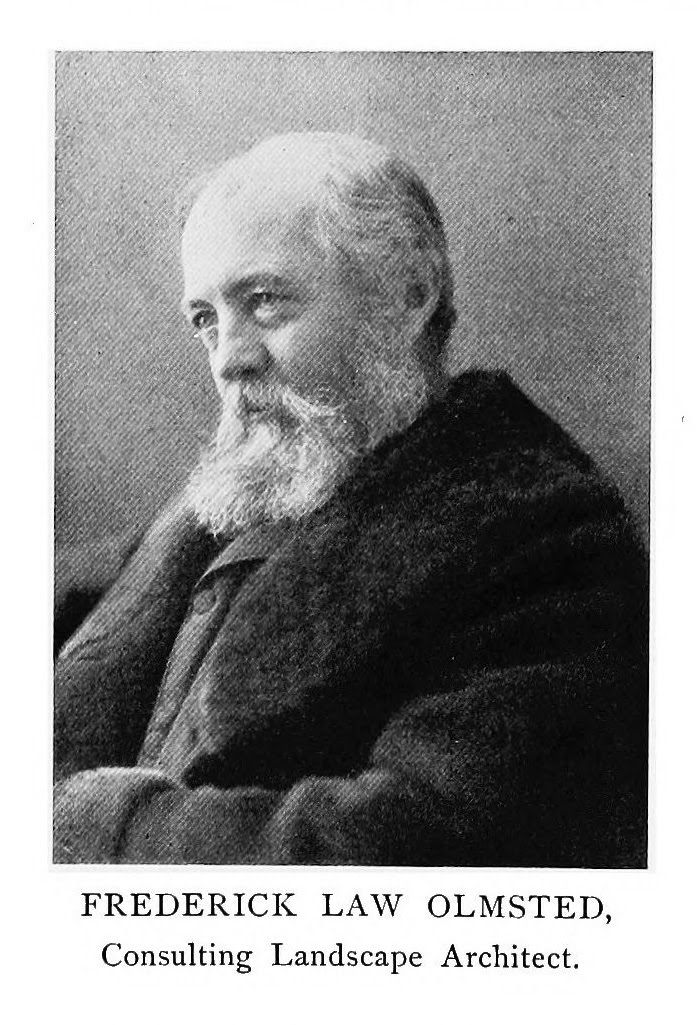
Frederick Law Olmsted, Consulting Landscape Architect of the 1893 World’s Columbian Exposition. [Image from Johnson, Rossiter A History of the World’s Columbian Exposition Volume 1 – Narrative (D. Appleton and Co., 1897).]
A REPORT UPON THE LANDSCAPE ARCHITECTURE OF THE COLUMBIAN EXPOSITION TO THE AMERICAN INSTITUTE OF ARCHITECTS.
A paper by Frederick Law Olmsted prepared for the American Institute of
Architects and read before the World’s Congress of Architects at Chicago.
This paper has been written at the request of the Institute, with the object of briefly accounting for such part of the preparation of the Exposition of 1893 as has come within the responsibility of the landscape architects, and as a contribution in this respect to a record of its genesis and development as a work of design. No comprehensive definition of the responsibility of the landscape architects has been recorded, and as to what is implied by the name of their office different understandings are had. For this reason, something needs first to be said in explanation of the view which will herein be taken.
Of pleasing scenery
In the Quarterly Review of 1820, page 303, there is an article written by Sir Walter Scott, from which it appears that this master of words did not approve of the term “landscape gardening,” which was then coming into popular use. His objection to it was that it tended to confusion between two classes of purposes, or motives of art, which could not well be blended together. To make this objection clear, it may be observed that the word garden comes to us from the same root with girdle, girth, garth and others to be found in every European tongue, all of which imply something limited, restrained and separated from what exists beyond or about it, or that is the cause of such limitation, restriction or separation. From remote times, the word in its various forms—English, Spanish, French, Italian, Scandinavian—has carried with it this idea of limitation and exclusion. We yet speak of “garden-flowers,” meaning certain flowers exclusive of others. Taking up a book with the title “A Garden of Verse,” we should understand it to be a selection of verse. Being told at a farm-house that one of the family of the house is “in the garden,” no countryman would think that this meant either simply out-of-doors, or in a stable-yard, or an orchard, or a common cultivated field, a grove, a park or a pasture. The word implies reference to a limited, defined and exclusive space, and it may be used in this way antithetically to the word landscape, the application of which is so comprehensive that it may take in houses, lawns, gardens, orchards, meadows, mountains and even the sky, with the stars to the remotest nebulae.
The word landscape is often used by accurate writers interchangeably with the word scenery, as, for example, by Gilpin in his series of works on the scenery of Great Britain; also by Hamerton in a recent treatise on landscape written from the point-of-view of a landscape painter.
A distinction implied by the word landscape unfitting it to be compounded with the word garden is indicated by Hamerton when he says that: “Much of the comprehensiveness of natural scenery depends upon the degree in which mass appears to predominate over detail. In perfectly clear weather, a mountain does not look nearly so grand as when … its nearer details are only partially revealed amidst broad spaces of shade. So it appears with other elements of landscape—they lose in comprehensiveness as the details become more visible.” Thus, for the enjoyment of landscape beauty, we are to regard the detail of what we see mainly as it affects the character and expression of masses, these masses being considered as elements of composition and perspective. On the other hand, for the enjoyment of garden beauty as such, we must scrutinize objects of detail discriminatingly. We must see roses as roses, not as flecks of white or red modifying masses of green.
Lastly, to understand aright the term “landscape architect,” we must bear in mind that the word architecture is not limited in application to works of building. The Almighty is referred to as the Architect of the Universe. Plutarch writes of the architecture of a poem, meaning the plotting of it. “The architect of his own fortune” is an old proverbial term yet commonly used in our newspapers, and is applicable as well to a banker or a miner as to one whose fortune has been made by directing works of building.
In view of the considerations thus presented, when the office of landscape architects to the Exposition was created, what, in the absence of specific instructions, was to be understood as the leading duty of that office? The answer assumed by those to whom the title was applied was that their leading duty must be to reconcile the requirements of the problem which the directors had before them in respect to buildings, and means of access to, and means of communication between, buildings, with the requirements of pleasing scenery and of scenery which would be pleasing, not because of the specific beauty of its detail, but because of the subordination and contribution of its detail to effective composition of masses as seen in perspective.
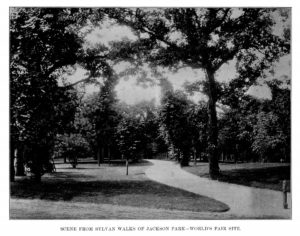
Scene from Sylvan Walks of Jackson Park. [Image from Campbell, James B. Campbell’s Illustrated History of the World’s Columbian Exposition, Volume I (M. Juul & Co., 1894).]
A choice of difficulties
Adopting such a view, the first thing to be noted in an account of the landscape architecture of the Exposition is this:
Immediately after the settlement in the Directory of the question of its own organization and rules, the question of a choice of sites came up, and it soon appeared that the debate of it was likely to be inconveniently prolonged. Thereupon the suggestion was made that expert counsel upon it might be desirable, and an inquiry was addressed to our office as to the terms upon which counsel could be had. Upon receipt of our reply by telegraph, we were asked to come to Chicago as soon as practicable. We did so by the next train, and, upon arrival, were presently taken to examine in succession seven proposed sites, three on the Lake and four inland.
The country about Chicago is flat and mainly treeless, except that in a few places there are small areas of dense woods. Its subsoil generally and its surface soil largely is a tenacious brick-clay. The climate in the spring is severe under successive alternations of southerly and northerly winds. The latter sweeping over the icy lake from the semi-arctic regions north of Lake Superior, the demand upon energy of vegetation is apt to be peculiarly trying. Accordingly, the choice of a suitable site was necessarily to be a choice of difficulties. Of the seven sites to which our attention was called, there was not one the scenery of which would recommend it if it had been near Boston, New York or Philadelphia. After our first general review of the premises, we adopted the opinion that nothing was to be found on any of the inland sites that could be weighed against the advantages, in respect to scenery, of the Lake Shore. Next, as to the sites on the shore, we concluded that, provided suitable means of transportation for goods and passengers between the town and the place could be secured, the northernmost of those proposed would be the best. By comparison with the most nearly competing site, it would require less outlay to prepare the ground and establish suitable means of interior transportation, water-supply, drainage and sewerage; the great marine commerce of Chicago would be passing in review before it at a suitable distance for spectacular effect; an arrangement of buildings simpler and much grander than elsewhere would be practicable, and the buildings would have a much better setting and framing of foliage provided by standing woods, fairly vigorous, and of sufficient height to serve as a continuous background.
But a committee of the Directory, taking up the question of transportation between this site and the central parts of the town, advised us that the railroad companies concerned could not be induced to make the outlay of capital required for such arrangements of transportation as we thought needful. Thereupon we fell back on the southernmost of the sites proposed on the Lake, which went by the name of Jackson Park.
Our report favoring this place excited much remonstrance. Opposition to it was concentrated in favor of an inland site nearby, known as Washington Park, the advantages of which were thought to be so great and so obvious that a leading member of the National Commission assured us that after an inspection of the two sites in question, not one vote in ten could be got for our proposition. In the few days that intervened before the Commission met, we gave the reasons of our choice as well as we could in private conversation, but I do not think we accomplished much. In the end the Commission accepted our advice, not because a majority of its members understood the grounds of it, but because they could not be led to believe that we should have given this advice without having, as experts, sound reasons for doing it. The result was due to respect for professional judgment. Comparing this experience with some in my earlier professional life, I can but think that it manifests an advance in civilization.
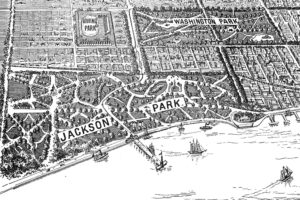
A bird-eye view of Jackson Park. [Image from The World’s Columbian Exposition Illustrated, February 1891.]
The place was forbidding
Unquestionably, to common observation, the place was forbidding. At different periods in the past, sand-bars had been formed in the lake a few hundred feet from, and parallel with the shore. The landward one of these, gradually rising, would at length attain an elevation above the surface of the water. There would then be within this bar a pool accurately definable as a lagoon. Gradually, in this case, lagoons thus formed had been filled nearly to the brim with sand drifting from the outer bar and had been turned into marshes. Thus nine-tenths of the surface of the site, or, in fact, all of it that had not been artificially made otherwise, consisted of three ridges of beach sand, the swales between which were more or less occupied by boggy, herbaceous vegetation. Upon the innermost two of the ridges vegetable mould had gathered and trees had sprung up in scattered groups. The most important of these trees were oaks. The situation being extremely bleak, the soil subject to be flooded, and the sandy sub-soil water-soaked, these had had an extremely slow growth. The largest were about forty feet in height. They were very feeble and many of them dilapidated through loss of limbs broken off by gales from the lake.
A more serious difficulty than any involved in this consideration was found in the circumstance that the level of water in the lake, and consequently in the marshes, was fluctuating, and this not only from day to day, as would be determined by winds at a distance drawing it off or backing it up, but its average level varied from year to year. An engineer who had been in charge of operations upon the Lake Shore, and who had had occasion to study the matter with accuracy, advised us that the probabilities were that in 1893, the average elevation of the surface of the lake would be four feet higher than it was at the time when we were studying the plan, or than it had been during the year before. It will be readily understood how difficult it became to forecast landscape effects in a region of low shores, without knowing within four feet what the level of the water was to be by which these shores were to be washed.
The Jackson Park site had, twenty years before, been selected as a site to be reserved for a public park. If a search had been made for the least park-like ground within miles of the city, nothing better meeting the requirement could have been found. It will, then, naturally be asked: Why was such a place fixed upon for a park? I have not the specific knowledge required for an answer, but I may mention that it is a common thing with town governments when they find bodies of land which, because of their special to graphical condition, are not favorable to the ends of dealers in building lots, to regard them as natural reservations for pleasure-grounds; to label them accordingly on their maps, and to refrain from ordering streets to be laid out across them. This is not peculiarly a Western custom. The sites for the Central Park, for the Morningside Park, for the Riverside Park, for the Mount Morris Park, for Tompkins Square, and, no doubt, for other public grounds in the City of New York, were thus selected. So was the site of the public ground in Boston, officially called the Fens, but popularly known as the Back Bay Park. Sites having been thus obtained, landscape architects are asked to contrive how pleasure-grounds can be made of them. It has been so, I believe, in London, conspicuously in the case of Battersea Park. And it may be remembered that the opportunity of making the Tuileries Garden in Paris occurred because, while the city had been building out about the place, the necessary ground had been held in reserve while the clay which it contained was being removed to be used for making roofing-tile. In the Millennium it may be hoped that landscape architects will be employed to select land with regard to the specific purpose for which it is to be used. When that is the case, the making of a park will be less costly than it is at present.
At the time the land and water of Jackson Park had been taken for a public park, I was in partnership with Mr. Calvert Vaux, and we were asked to devise a plan for making it available for a public pleasure ground, together with the site now known as Washington Park and the strip of land between them, now known as the Midway.
As the starting-point for the development of the proposition which we then made, the suggestion was adopted that dredging-boats might be employed, to begin at the lake and first reopen the old lagoons, taking the excavated material to be lifted out of their bottoms to form the basis of higher, more undulating and varying banks resting on the old sand-bars; next, to move through the Midway and so on to the inland park site, everywhere lifting out the material needing to be removed in order to open a channel in which they could float, and so shifting this material to one side or the other as to provide the base of varying shores, these shores to be afterwards covered with soil and landscape masses of vegetation.
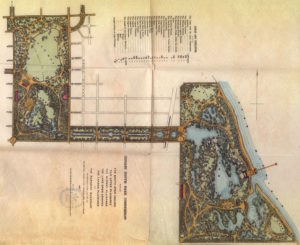
Olmsted & Vaux’s 1871 South Park Plan [Image from the Chicago Park District].
Mortifying and disappointing
When Jackson Park was chosen as the site for the World’s Fair, the general landscape design of no part of the plan, of which the expedient I have described was the germ, had been carried out. In the Washington Park part of the scheme, a good deal had been done following the leading outlines of the plan, but with a modelling of surfaces and a choice of material and disposition of foliage looking to condition of detail rather than of masses, and with entire disregard of the elements of mystery through effects of aerial perspective, and the complicated play of light and shadow and of reflected tints in extended composition.
In the nominal carrying out of plans in the preparation of which I have had part there have often been sacrifices of the designs of these plans which have been mortifying and disappointing. In no other case, however, had the disappointment been so great as in this. Nowhere else had the opportunity for forming agreeable scenery been so lost. But, in the lagoon district, what little had been done had not been done unwisely.
Coming to consider what might yet be done with this same lagoon district suitably for the purposes of the Exposition, the question at once came up how far the general theory of the old plan for a public pleasure-ground to be formed upon it could be made available to the special purpose of the Exposition.
As a result of this consideration, we came to the conclusion that the element of the water-ways in the original plan being carried out, retaining-walls being built in various places for holding up the excavated material to be piled upon the shores, so that in these places terraces would be formed, the necessary buildings of the Fair could be advantageously distributed upon the surrounding sandy ridges.
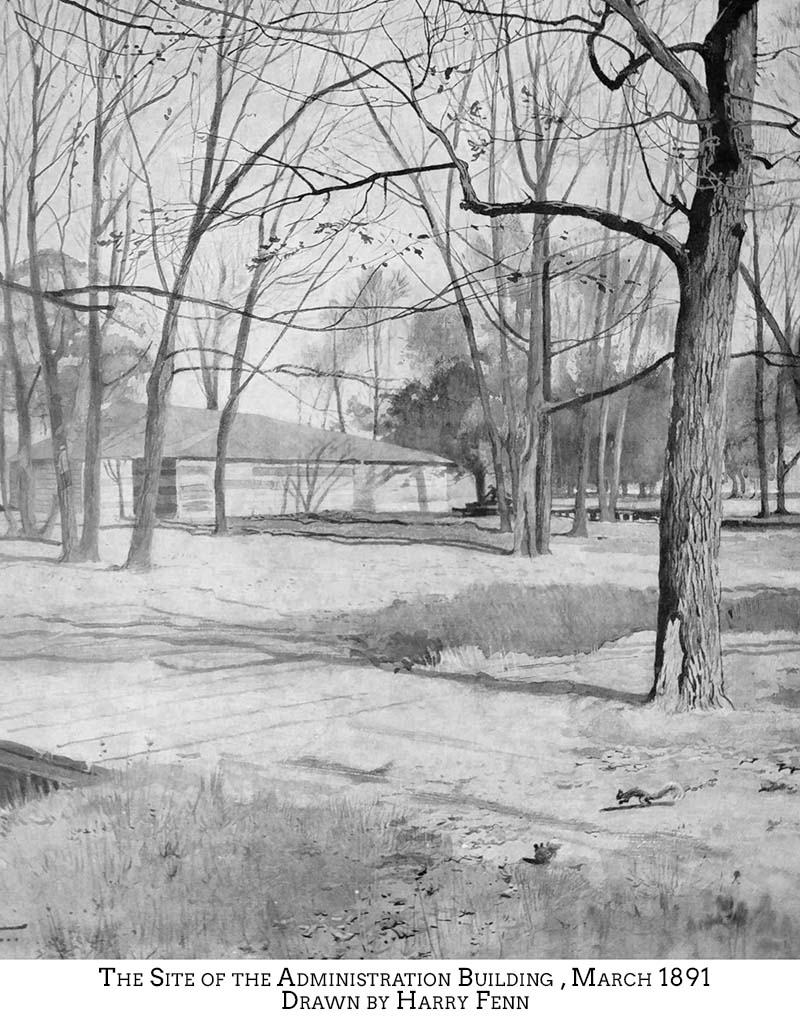
An architectural character in harmony with the buildings
Before making their formal report favoring the choice of Jackson Park for the site of the Exposition, the landscape architects took counsel with Messrs. Burnham & Root, presenting their views of the manner in which, this site being adopted, it should be used, and obtaining confirmation of them, more especially with reference to the expediency of distributing the needed large buildings upon the sandy ridges, and of spreading out these ridges suitably for the purpose by retaining-walls to be backed by the excavated material from the lagoons. It may be observed that, to accomplish this purpose in various localities where otherwise lagoons with shores of a natural character would become unsuitable for boats, it was thought best to give them the character of canals; that is to say, to make them formal and give their banks, which would necessarily be walls, an architectural character in harmony with the buildings to which, in a near perspective view, they would form foregrounds.
Mr. Burnham, in his report of operations, addressed to the President of the Exposition on the 24th of October, 1892, thus describes the process of forming the first complete graphic sketch illustrative of the design:
“After consideration of sketches made on the ground, … a crude plot, on a large scale, of the whole scheme was rapidly drawn on brown paper, mostly with a pencil in the hand of Mr. Root, whose architectural prescience and coördinating talent was of invaluable service to the result. The plot, formed in the manner described, contemplated the following as leading features of design: That there should be a great architectural court with a body of water therein; that this court should serve as a suitably dignified and impressive entrance-hall to the Exposition, and that visitors arriving by train or boat should all pass through it; that there should be a formal canal leading northward from this court to a series of broader waters of a lagoon character, by which nearly the entire site would be penetrated, so that the principal Exposition buildings would each have a water as well as a land frontage, and would be approachable by boats; that near the middle of this lagoon system there should be an island, about fifteen acres in area, in which there would be clusters of the largest trees growing upon the site; that this island should be free from conspicuous buildings, and that it should have a generally secluded, natural, sylvan aspect, the existing clusters of trees serving as centres for such broad and simple larger masses of foliage as it would be practicable to establish in a year’s time by plantations of young trees and bushes. Because the water in the lagoons would be subject to considerable fluctuations, it was proposed that their shores should be occupied by a selection of such aquatic plants as would endure occasional submergence and yet survive an occasional withdrawal of water from their roots. Time pressing, the pencil, large-scale, brown-paper plot above described, with a brief written specification, almost equally sketchy, was submitted to the Corporation, and, after due consideration, on the 1st of December, 1890, was adopted as the plan of the Exposition.”
The question may be asked: In what degree at this early period was the result forecast which has since been attained in respect to the effect of boats, bridges and water-fowl and overhanging foliage on the lagoons? The answer is that it was quite fully anticipated in a general way. The effects of the boats and water-fowl as incidents of movement and life; the bridges with respect to their shadows and reflections, their effect in extending apparent perspectives and in connecting terraces and buildings, tying them together and thus increasing unity of composition–all this was quite fully taken into account from the very first, and the style of boats best adapted to the purpose became, at once, a topic of much anxiety and study.
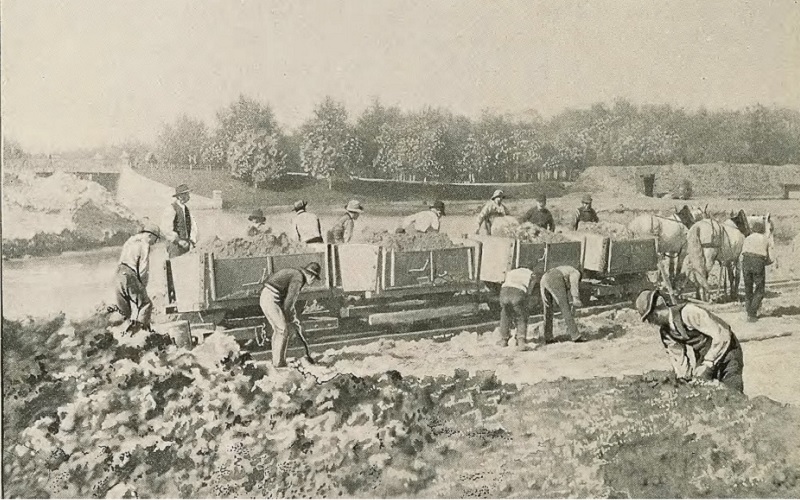
Laborers working to landscape Jackson Park in 1891, near the bridge connecting the Lagoon and the North Pond. [Image from World’s Columbian Exposition Illustrated, June 1891.]
A cordial and unqualified approval of the plan
The next important step in the progress of the enterprise to which reference is here necessary was that taken by Mr. Burnham, which resulted in the meeting at Chicago of the Advisory Board of Architects, with Mr. Hunt as its Chairman. The landscape architects were made members of this board, and their general plan came up for critical review. Many suggestions for its amendment were made by the building architects, but in nearly all cases counter-suggestions were offered by others of them, and, the balances of advantages being weighed, the result was at length a cordial and unqualified approval of the plan as originally presented, and this was duly expressed by a resolution and report to the Commission.
The general plan was, however, afterwards modified in certain particulars. These particulars were the abandonment of a proposed outer harbor for which the landing pier now seen was substituted; the introduction of the Peristyle, and of the Colonnade at the end of the south transept of the main court. All of these changes resulted from suggestions of the building architects, cordially welcomed by the landscape architects.
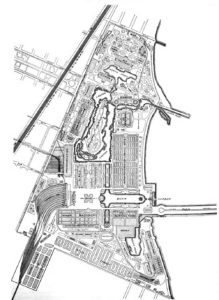
A map of the World’s Columbian Exposition. [Image from Bancroft, Hubert Howe The Book of the Fair (The Bancroft Company, 1893).]
A focal point of interest to be regarded as the centre of design
The general plan was later modified in one matter, to its great injury. Two of our firm had visited the last World’s Fair in Paris, while it was in preparation, under the guidance of its landscape architect. The third of our number, Mr. Codman, had passed several months in Paris, while the Fair was in progress. We all thought, and Mr. Codman was particularly strong in the conviction, that it was an unfortunate circumstance that visitors so generally entered the Paris Exposition at points and by ways not adapted either to give them a grand impression, or to provide a convenient point of dispersal for systematic observation. This in Paris grew largely out of the situation of the Exposition. There was no similar difficulty in the Chicago situation and the very first step in our revision of the old park plan in adaptation to the requirements of the Fair was to fix upon a focal point of interest to be regarded as the centre of design, and to so place this centre that conveyances of all kinds, by land and by water, the railways and the boats, both those of the interior and those of the exterior, should conveniently discharge visitors into it and receive visitors from it. That it should thus be made a place of general exchange, a place for obtaining information and guidance, as well as a place of departures and returns, a spacious court was designed; the Administration Building was placed in this court; the buildings likely to be most frequented were placed so that they would open from it; the intramural railway was to have its principal station in it; the whole interior water system was planned with a view to easy connection with and through it by the small boats.
All railways and all steamboats were to conveniently receive and discharge passengers through it. A union station was provided for with the latter object in view. We intended that the Administration Building, which stands in this court, and this railway station should contain the principal provision of guides and wheel-chairs and the central office of a system of offices of “public comfort” to be in telephonic communication with it. We did all in our power to have this arrangement carried out. The failure to carry it out has added, in my opinion, to the cost of the Exposition and deducted much from its value. In reporting to you professionally, I have thought it necessary to say this, not in the least in a complaining way, but that it may go on record for the benefit of those who may have to deal hereafter with a similar problem. You will ask why we were unsuccessful? I do not fully know. I can only answer that our failure took the form of a failure of prolonged negotiations with the Illinois Central Railway.
At the period when the general plan was formed it was impossible to have building masses definitely in view except in the case of a few of the larger ones. Our instructions as to these were that a classification similar to that of the last Paris Exposition was to be contemplated, but that the buildings required under the classification would be a third larger than the corresponding buildings in Paris. We presumed that additional buildings would be wanted and that they would be of smaller but of varying size. For these presumed, but as yet undetermined, smaller buildings, we held three large spaces in reserve. First, for such as would be wanted for the livestock exhibits, an area at the south end; second, for the distinctive office and “headquarters” buildings of the National and State Committees, an area at the north end; third, for miscellaneous exhibition-buildings of a smaller class, the strip of land called the Midway. We calculated that restaurants would be established in the great Exposition buildings, and that the terraces of some of these buildings would be occupied to a considerable extent with refreshment tables and chairs, under awnings. We did not suppose that there would be many small buildings scattered about between the main great buildings, nor do I think that it was at the outset contemplated by those in direction that there would be. Afterwards they were seen to be financially desirable.
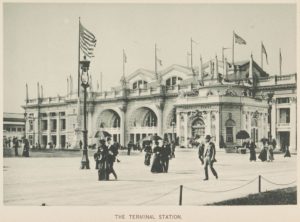
Terminal Station. [Image from Arnold, C. D.; Higinbotham, H. D. Official Views of the World’s Columbian Exposition (Press Chicago Photo-gravure Co., 1893).]
In contrast with the artificial grandeur and sumptuousness
Also, it is to be noted that it was our original intention and that this intention was fully set forth, to have what has since been called the Wooded Island, occupying a central position, held free from buildings and from all objects that would prevent it from presenting, in connection with the adjoining waters, a broad space in contrast with the artificial grandeur and sumptuousness of the other parts of the scenery. After a time demands came for the use of the island for a great variety of purposes, and at length we became convinced that it would be impossible to successfully resist these demands. When we reluctantly reached this conclusion, the question with us was which of all the propositions urged, if adopted, will have the least obtrusive and disquieting result? Probably we were fortunate in securing the occupation of the island only by the temple and garden of the Japanese, and for the display of horticultural exhibits. Nevertheless, we consider that these introductions have much injured the island for the purpose which in our primary design it was intended to serve. If they could have been avoided, I am sure that the Exposition would have made a much more agreeable general impression on visitors of cultivated sensibility to the influence of scenery.
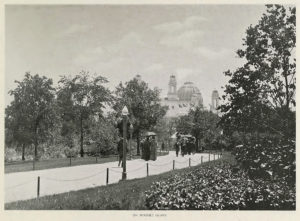
The Wooded Island. [Image from Bancroft, Hubert Howe The Book of the Fair. The Bancroft Company, 1893.]
Add so much disquiet to the already excessive disquiet
With regard to the subsequent occupation of ground by smaller structures, especially such as are of the class called pavilions and concession buildings, many of these have been inserted without consulting us; places being often given them in which they intercepted vistas and disturbed spaces intended to serve for the relief of the eye from the too nearly constant demands upon attention of the Exposition buildings. As a caution to those who will manage the next affair of a similar class, it is best to record the opinion that the effect of these little structures among the larger has been bad. I can best show our judgment of it by saying that it had been our original intention to use on the grounds a great deal more of gardening decoration in various forms than we have. We had, at considerable expense, provided materials for the purpose, largely in the form of plants propagated and kept last winter under glass. But at last when the time approached for making the intended use of this material, the spaces of the Exposition grounds not occupied by the larger building masses and trees appeared to us to be everywhere already a great deal too much divided and disturbed by little features intended to be more or less of a decorative character. So much was this the case that, after consideration, and with reluctance, we concluded that our intended floral decorations would add so much disquiet to the already excessive disquiet of the scenery, and so detract from the effect of the more massive elements, that they must be abandoned.
One other modification of the original plan must be referred to. The administration at one time contemplated the introduction of a branch railway, by which Illinois Central trains would be taken from the Midway to the station upon the main court through the Fair ground. To give room for this branch road, we were required to change the position assigned to the Horticultural Building, reduce the breadth of the lagoon, and modify the outlines of the island. Afterwards the railway project was abandoned, but in the meantime, work had been done compelling adherence to the unfortunate revision of the shores. It will readily be seen that the cramping of the water at this point has been a considerable loss, and that, had the advances and recesses of the foliage masses opposite the Horticultural Building been much greater than they are, a more picturesque effect would have been obtained.
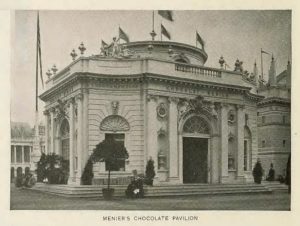
One of many smaller structures that occupied the fairground was the lovely Menier’s Chocolate Pavilion next to the Administration Building. [Image from Bancroft, Hubert Howe The Book of the Fair (The Bancroft Company, 1893).]
A most satisfactory and encouraging circumstance
Passing from matters of design to matters of construction: As to the more bulky preliminary operations of dredging and sub-grading, they were mostly affairs of large contracts, and, while we were constantly consulted, the preparation of details and the superintendence of the contractors’ works was made by the Director of Works mainly the duty of the engineer corps. The same was the case in a still greater degree with respect to the often extremely difficult and delicate matters of drainage, sewerage and water-supply throughout the grounds. It is only necessary, then, to say with reference to these matters, as well as to those of buildings, that our coöperative relations have been of a character to be looked back upon with pride and congratulation. Really, I think that it is a most satisfactory and encouraging circumstance that it could be found feasible for so many, men of technical education and ability to be recruited and suitably organized so quickly and made to work together so well in so short a time. I think it a notable circumstance that there should have been so little friction, so little display of jealousy, envy and combativeness, as has appeared in the progress of this enterprise. Too high an estimate cannot be placed on the industry, skill and tact with which this result was secured by the master of us all, yet I venture to say that, considering the impromptu way in which Mr. Burnham had to go to work, and the extremely varied antecedents in the matter of education, custom and habit of those through whom he had to operate, equal success would have been possible only in a country which was in a high degree, socially as well as politically, a republic.
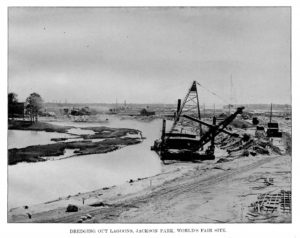
Dredging out lagoons in Jackson Park. [Image from Campbell, James B. Campbell’s Illustrated History of the World’s Columbian Exposition, Volume I (M. Juul & Co., 1894).]
We took all these hazards and difficulties into account
I have only to add a few statements in respect to that part of the work of which the landscape architects were placed especially and more independently in general superintendence.
On this point, I will observe, first, that we early recognized the importance of not entering upon undertakings which might lead to the requirement of outlays, the reasonableness of which could not be made plain to the Directory, or which we could not be confident that, in the progress of the work, the financial department would sustain. Also, we took well into account that various resources that would be available in any large capital of Europe would not, in Chicago, be at our command, and, further, that we should have to push much of our work very rapidly with unknown and untrained men. After completing operations of grading, draining and the supplying of suitable soils, we should have, for much of the ground, but one fall and spring for planting operations, for none of it more than two, and it is rare that a weak and sickly appearance is to be avoided in freshly-made plantations. We considered also that we had to deal with many inexactly known conditions—conditions, I mean, of climate, as of the occurrence of rains and floods and sudden inroads of severe frosts in the planting season; conditions of uncertainties as to how the bottom and banks of our excavations would behave, as, for example, how they would be affected by subterranean springs. To illustrate this latter hazard, I will mention that at important points, after our channels had been excavated, there were movements, slips and uprisings of the sandy bottoms, forming shoals, and, as the result of the subsequent re-dredging of these places, ad joining banks and slopes slid away and caved off. Through this process, and from the effect of ice which formed to the depth of two feet along the shores and remained late in the spring, we lost, in spite of all precautions, many thousand water-plants that had been collected, propagated and set with great painstaking.
From the start we took all these hazards and difficulties into account and devised our design at all points so that success in what we aimed at would not greatly depend on exact and refined local particulars, but on masses and broad general conditions.
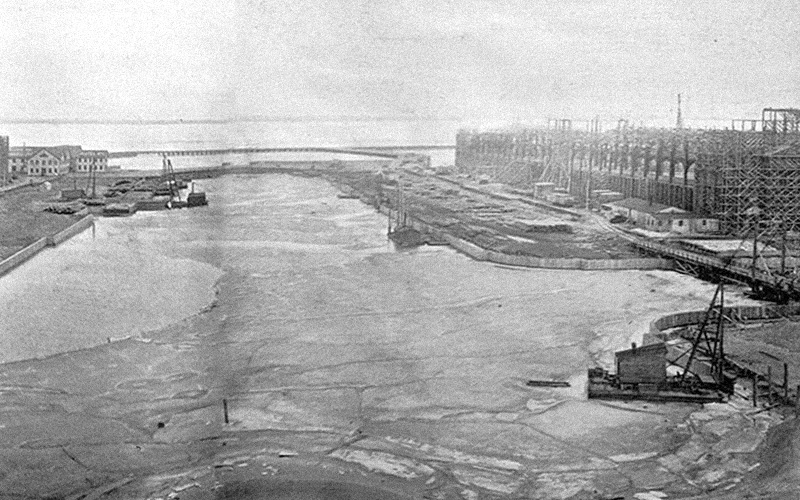
A winter scene of the Grand Basin. [Image from World’s Columbian Exposition Illustrated, Feb. 22, 1892.]
Varied in tints and pleasing in its shadows and reflections
One main difficulty to be considered was that of making sure of the clothing of several miles of newly-made, raw, sandy shores with a clean, graceful, intricate, picturesque green drapery, varied in tints and pleasing in its shadows and reflections. We knew that we could but little on the ordinary commercial agencies for the materials required for this end, and within a week after the work was put under our direction we had begun the gathering, by special collecting agencies, of the plants required. We placed our dependence mainly on two classes of these: first, willows, chiefly of the shrubby sorts, but in large variety; second, herbaceous, bog and water-side plants, principally such as are commonly known with us as flags, cat-tails, rushes, irises and pond-lilies. Some of these were propagated on the Fair grounds; a few were bought from nursery men and florists; much the larger part was obtained by parties organized and sent out for the purpose to various localities on the shores of lakes, rivers and swamps in Illinois and Wisconsin.
Altogether, we have planted on the shores of the lagoons one hundred thousand small willows; seventy-five large railway platform car-loads of collected herbaceous aquatic plants, taken from the wild; one hundred and forty thousand other aquatic plants, largely native and Japanese irises, and two hundred and eighty-five thousand ferns and other perennial herbaceous plants. The whole number of plants transplanted to the ground has been a little over a million.
Our chief executive in the immediate direction of working operations has been Mr. Rudolph Ulrich. He had never been employed under our direction before, but we had seen the results of rapid work carried on under difficulties by him and had formed a good opinion of his abilities to meet emergencies. On the very day of our appointment, we telegraphed across the continent to ascertain if he would be available. Our message reached him at a moment when he happened to have just left a California work in which he had been engaged, and he was at once secured. It had been our policy to encumber him as little as possible with directions in detail, but to explain to him our aims and trust largely to his discretion as to particulars. He has entered admirably into the spirit of the design, and the zeal, activity, skill and industry with which he has labored to carry it out cannot be too highly esteemed.
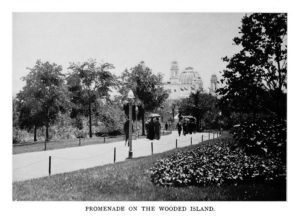
Promenade on the Wooded Island. [Image from Johnson, Rossiter A History of the World’s Columbian Exposition Volume 1 – Narrative (D. Appleton and Co., 1897).]

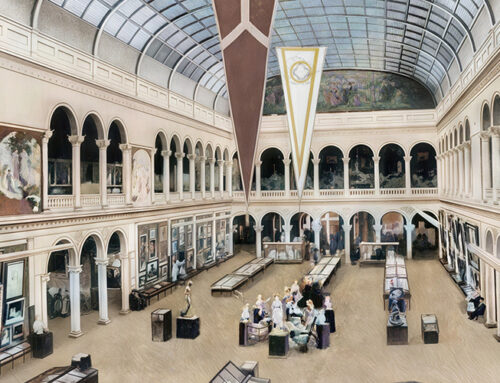
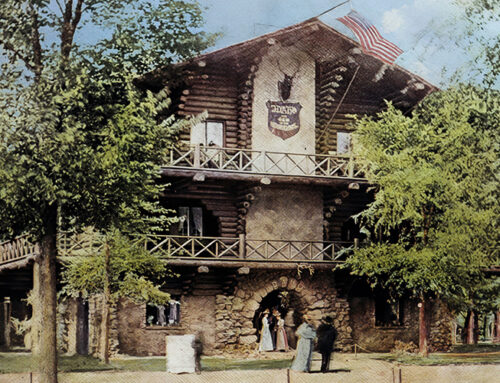
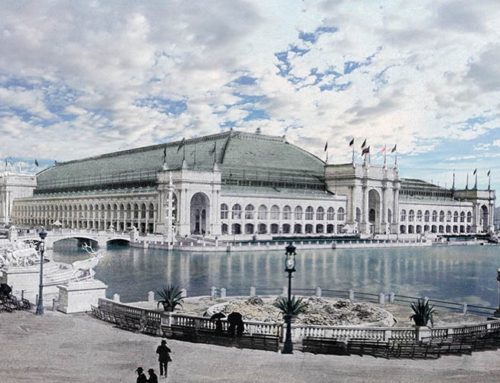

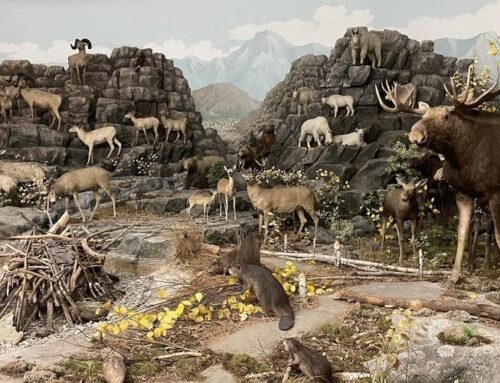
Leave A Comment